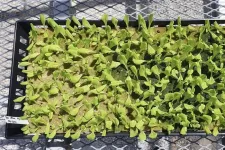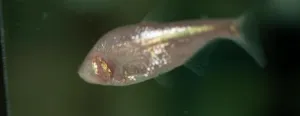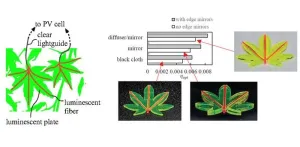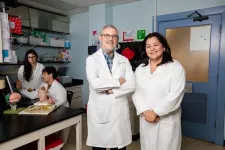(Press-News.org) FAYETTEVILLE, Ark. — As controlled environment agriculture and vertical farming gain a greater foothold in modern agriculture, a new $300,000 grant aims to enhance hydroponic lettuce production.
Kristen Gibson, director of the Arkansas Center for Food Safety and Arkansas Agricultural Experiment Station faculty member, is the lead researcher on the grant from the U.S. Department of Agriculture’s National Institute of Food and Agriculture. Gibson says the grant provides an opportunity to meet the needs of the hydroponics industry.
“The industry is always looking for what’s going to help them grow the best product, increase profit and not cause disease,” Gibson said.
The funding comes at a time when U.S. hydroponic production of lettuce is growing. According to a January 2024 report by the USDA, hydroponic lettuce production more than doubled over five years, from 15.4 million pounds in 2014 to 36.4 million pounds in 2019. This rapid growth calls for a greater understanding of plant pathogens and food safety risks in these systems, Gibson said.
“It’s a growing industry,” Gibson said. “They are asking for solutions, and we’re trying to help provide them with some guidance on what we know.”
The focus of the research will be to evaluate soilless substrates as a critical point for controlling pests and pathogens, Gibson said. Soilless substrates serve the same function as soil in traditional agricultural systems, physically supporting the plant and acting as a medium to deliver oxygen, nutrients and water to plant roots. Some common examples of soilless substrates include volcanic rock, coconut coir, sand, perlite and vermiculite. Soilless substrates, in general, represent some of the most promising points for growers to apply an intervention to prevent pests and pathogens, Gibson said.
“They want to see what’s out there — what can be validated — because soilless substrates are often considered a point where some of these plant pathogens could be introduced,” she said.
Gibson noted the research will not only address pathogens that make people sick but also pathogens and pests that make the plants sick.
“If we combine strategies where you’re addressing plant pathogens at the same time as food safety, it works better,” she said.
Co-principal investigators on the project include Rupesh Kariyat, associate professor of insect-plant interactions and chemical ecology in the entomology and plant pathology department; and Ryan Dickson, assistant professor of greenhouse and controlled-environment agriculture in the horticulture department. Gibson, Kariyat and Dickson conduct research for the Arkansas Agricultural Experiment Station, the research arm of the University of Arkansas System Division of Agriculture.
Roadmap for safer hydroponic production
Gibson said the first objective of the project is to establish the impact of soilless substrates on pathogen and pest risk. Using a controlled greenhouse environment, the research team will assess how foodborne pathogens and plant pests persist in different kinds of substrates.
“The first part is to look at a lot of the substrates that are available on the market,” Gibson said. “We want to figure out which ones are actually aiding in the proliferation or the persistence of plant pathogens, plant pests, or human pathogens of concern.”
For the project’s second objective, the researchers will test the ability of different biopesticides — or non-synthetic pesticides — to control pests and pathogens in different substrates. A key part of this step, Gibson said, is to consider the scale of commercial operations.
“We can do application on a small scale, but when you think about a commercial scale, you want to figure out what’s going to make this feasible for growers,” she said.
The final objective of the project is to translate the research findings from the first two objectives into best practices for hydroponic lettuce growers. Gibson said the team will develop a set of comprehensive training materials for growers through extension activities, including workshops and training sessions with producers.
This grant is part of the Agriculture and Food Research Initiative’s Critical Agriculture Research and Extension program, from USDA-NIFA. The project award number is 2024-68008-42637.
To learn more about Division of Agriculture research, visit the Arkansas Agricultural Experiment Station website. Follow us on X at @ArkAgResearch, subscribe to the Food, Farms and Forests podcast and sign up for our monthly newsletter, the Arkansas Agricultural Research Report. To learn more about the Division of Agriculture, visit uada.edu. Follow us on X at @AgInArk. To learn about extension programs in Arkansas, contact your local Cooperative Extension Service agent or visit uaex.uada.edu.
About the Division of Agriculture
The University of Arkansas System Division of Agriculture’s mission is to strengthen agriculture, communities, and families by connecting trusted research to the adoption of best practices.
Through the Agricultural Experiment Station and the Cooperative Extension Service, the Division of Agriculture conducts research and extension work within the nation’s historic land grant education system.
The Division of Agriculture is one of 20 entities within the University of Arkansas System. It has offices in all 75 counties in Arkansas and faculty on five system campuses.
The University of Arkansas System Division of Agriculture offers all its Extension and Research programs and services without regard to race, color, sex, gender identity, sexual orientation, national origin, religion, age, disability, marital or veteran status, genetic information, or any other legally protected status, and is an Affirmative Action/Equal Opportunity Employer.
# # #
END
New Haven, Conn. — In humans, the process of learning is driven by different groups of cells in the brain firing together. For instance, when the neurons associated with the process of recognizing a dog begin to fire in a coordinated manner in response to the cells that encode the features of a dog — four legs, fur, a tail, etc. — a young child will eventually be able to identify dogs going forward. But brain wiring begins before humans are born, before they have experiences or senses like sight to guide this cellular circuitry. How does that happen?
In a new ...
Hamza Memon and Nicholas Panzo, students at Texas A&M University School of Engineering Medicine (ENMED), are leading an innovative project at the intersection of sports and ophthalmology to improve National Football League (NFL) officiating . Rooted deeply in Houston’s vibrant sports culture, these Class of 2026 students combine their interest in ophthalmology and their love for sports to contribute significantly to a groundbreaking project with the NFL.
The two students met during a summer engineering program and quickly bonded over their shared aspirations in sports and ophthalmology. This friendship led ...
Over thousands of years, cavefish evolved and lost their vision, earning the moniker “the blind cavefish,” but some cavefish also developed an inordinate number of taste buds on the head and chin.
In a new study, now published in the Nature journal Communications Biology, scientists at the University of Cincinnati have determined when the taste buds start to appear in areas beyond the oral cavity. The study was supported by the National Science Foundation.
To begin, blind cavefish evolved in cave ponds in northeastern Mexico. They are pale pink and nearly translucent compared to their silvery counterparts ...
A technique that uses videos and machine learning to quantify motor symptoms in early-stage Parkinson’s disease could help reveal signs of the disease and other movement disorders earlier, which could lead to better treatment outcomes.
In a study just published in Parkinsonism and Related Disorders, a team of researchers from the University of Florida and the Fixel Institute for Neurological Diseases shows that video assessment can help detect early Parkinsonism in an individual by comparing the movement of the left and right sides of their body. The approach, researchers say, exploits the fact ...
Since its invention in the 1970s, the luminescent solar concentrator (LSC) has aimed to enhance solar energy capture by using luminescent materials to convert and concentrate sunlight onto photovoltaic (PV) cells. Unlike traditional concentrators that rely on mirrors and lenses, LSCs can harvest diffuse light and have been used in applications such as building-integrated photovoltaics, where their semitransparent and colorful nature offers aesthetic benefits. However, scaling up LSCs to cover large areas has been challenging due to issues like self-absorption of photoluminescent (PL) photons within the waveguide. Researchers ...
EL PASO, Texas (Aug. 15, 2024) — Researchers at The University of Texas at El Paso will undertake a new study that could lead to improved nicotine cessation treatments for women. The work is supported by a new $2.5 million grant from the National Institute on Drug Abuse (NIDA), part of the National Institutes of Health (NIH).
Principal investigator Laura O'Dell, Ph.D., a professor in the Department of Psychology at UTEP, will lead the multidisciplinary study into how stress produced by nicotine withdrawal is intensified by variations in ovarian hormones in women.
The study ...
WASHINGTON, D.C. – To support vulnerable communities responding to continued and extreme climate effects, the Department of Energy (DOE) today announced $10 million in funding for innovative Climate Resilience Centers (CRCs) in 10 different states. University-led research teams will leverage the world class modeling, data and research capabilities from DOE national laboratories customized for their local regions with a focus on climate prediction of weather hazard risks to better prepare communities. The CRCs are part of the Biden-Harris Administration’s Justice40 Initiative and are designed to ensure that all Americans are benefitting from scientific research.
“Every ...
KENNEDY SPACE CENTER (FL), August 15, 2024—The International Space Station (ISS) National Laboratory is collaborating with NASA on a solicitation for space-based research addressing some of the most significant diseases of our time—such as cancer, cardiovascular disease, and neurodegenerative disease. ISS National Lab Research Announcement (NLRA) 2024-09: Igniting Innovation: Science in Space to Cure Disease on Earth, released in partnership with NASA’s Biological and Physical Sciences division, is aimed at overcoming challenges hindering progress in disease prevention, diagnosis, and treatment. This NLRA ...
A new Yale study finds that the effects of long COVID have caused many Americans to miss extensive work time, and that 14% of study participants reported not returning to work in the months after their infection.
The findings, published recently in PLOS One, suggest that long COVID may have affected millions of Americans and generated steep economic costs, highlighting the need for policies to support those with the condition, researchers said.
The study drew on a long-term survey of individuals who contracted COVID-19 — dubbed Innovative ...
In a Policy Forum, Brian Prest and colleagues discuss how new regulatory guidelines from the U.S. Office of Management and Budget (OMB), known as Circular A-4, could impact the social cost of carbon (SCC). The new equity weighting approach recommended by the OMB, they say, leads to a dramatic increase in SCC estimates, and thus requires careful dialogue and discussion. The social cost of carbon is an estimate of the economic damage caused by emitting an additional ton of carbon dioxide into the atmosphere. It helps guide decisions about balancing the costs of reducing emissions with the benefits of mitigating climate change. Traditionally, ...





